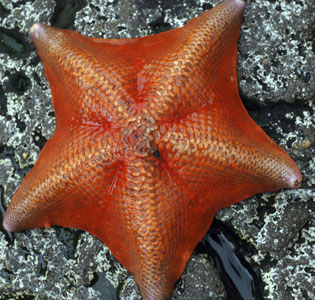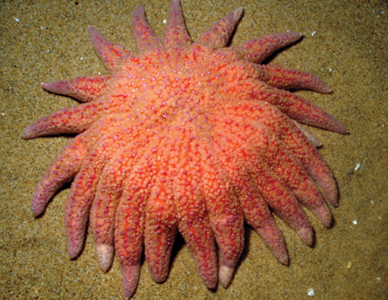Bay Area residents and visitors alike are sure to be star-gazing in the daytime this month, heading to the waterfront to watch the Blue Angels soar overhead during Fleet Week.

A Bat Star from the Aquarium of the Bay.
By Kati Schmidt
Published: October, 2010
Bay Area residents and visitors alike are sure to be star-gazing in the daytime this month, heading to the waterfront to watch the Blue Angels soar overhead during Fleet Week. Before and after the air show and 364 days each year, Bay-lovers also have the chance to see, learn about and even touch water-submerged stars at Aquarium of the Bay. Sea stars (don’t call them starfish, they’re invertebrates) are part of phylum Echinodermata—meaning “spiny skin” in Latin—which includes 6,000 species of sea stars, sand dollars, sea urchins and sea cucumbers.
The sea star population alone includes about 1,800 species in a rainbow of colors and sizes that range from that of a small bug to a large clock. Aquarium of the Bay exhibits species including bat, sunflower, leather, ochre and pink stars.
“From the crimson-red blood star (Henricia leviuscula) to checkered-colored bat stars, sea stars bring brilliant colors and diversity to San Francisco Bay and the California coast,” said Mike McGill, collections coordinator at Aquarium of the Bay. McGill notes that within San Francisco Bay, ochre and pink stars are the most commonly found species.
What a sea star lacks in blood, it makes up for in its water vascular system, an attribute unique to echinoderms. This system consists of a network of water-filled tubes called tube feed or podia, which help sea stars move and breathe. By contracting and expanding water vascular system chambers, sea stars can control water movement into certain tube feet to extend them. The tube feet also include muscles, used to retract them. This expanding and retracting movement enables the sea star to walk. The tube feet also include suckers at the end, used to capture prey or hold onto rocks and avoid being swept by tides. If flipped over, a sea star can rotate one arm and pull itself over.
Rather than relying on eyeballs, sea stars see through eye spots, located at the end of each arm. These red spots provide limited vision, allowing the sea star to sense light from dark.
Sea stars are not picky eaters and dine on basically anything they can get their tube feet on: clams, oysters, some snails or even other sea stars. A sea star’s mouth is located on its bottom side, nestled amongst the tube feet.
The saying “eyes bigger than stomach” takes on a slightly different meaning in the context of a sea star’s anatomy. If the food choice is larger than its mouth, never fear—the animal will flip its stomach out of its mouth, secrete a digestive enzyme that emulsifies the prey and then absorb the puree. After its meal, it draws its stomach back in through its mouth, without leaving a crumb behind.
Regeneration is another important part of a sea star’s anatomy. Sea stars can regenerate lost arms, and in some cases, an entire sea star can re-grow from a severed arm.
In the sea star kingdom, sunflower stars (Pycnopodia helianthoides) are king. While they may begin their life with five arms, by the time they reach maturity, they may have sprouted up to 24 arms and can span over three feet in total length, from arm tip to arm tip. This massive amount of arms makes for a staggering number of tube feet—up to 15,000—that enable the animal to move along at a record-setting clip of 200 feet per hour.
Brightly colored bat stars (Asterina miniata) play a garbage-collector role by munching on dead animals and algae. While these animals get a gold star for helping clean our ocean ecosystems, they do not receive such high marks for sportsmanship. When bumping into another bat star, for example, a simple apology is not good enough. The animals engage in arm interaction—a king of the mountain-style game where they place arms over one another in an effort to disrupt other stars’ movements and feeding activities.
At the Aquarium, visitors see sea stars around nearly every corner in several of the Discover the Bay exhibit tanks, in both Under the Bay exhibit tunnels (look for sunflower stars on the walls of the second tunnel) and in its Touch the Bay exhibit. Helping to keep its sea stars well-fed and not reaching for their tank-mates, the Aquarium’s naturalists lead invertebrate feeding presentations daily at 3 p.m. A full list of daily and special discussions and hands-on activities at the Aquarium can be found at www.aquariumofthebay.org.
After visiting the Aquarium, if you’re inspired to take your tide pool exploration even further, you’re in luck—many active tide pools are with an hour’s drive of San Francisco. Local favorites include the Fitzgerald Marine Reserve in Moss Landing, Duxbury Reef and Agate Beach in Mesa Bolinas and Bodega Head in Bodega Bay. A full list of North Bay tide pool destinations can be found on the Farallones Marine Sanctuary Association’s website: farallones.org/index.php.
When visiting tide pools, it is important to think of them as living museums. Enjoy the beauty of sea stars and other animals, but respect their habitat; practice a look-but-don’t-touch policy (or, if you must touch, a touch-but-do-not-move policy) to help keep these tide pool stars safe and healthy.

Sunflower stars can have up to 24 arms!



